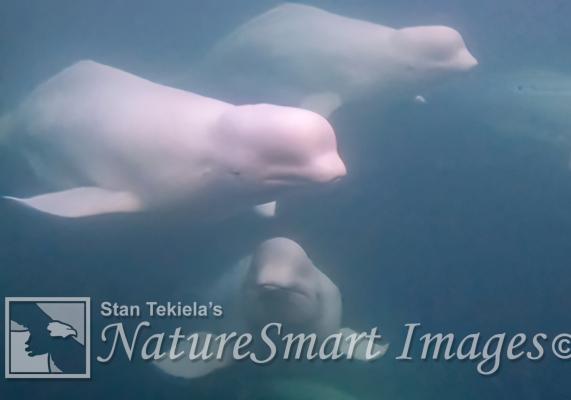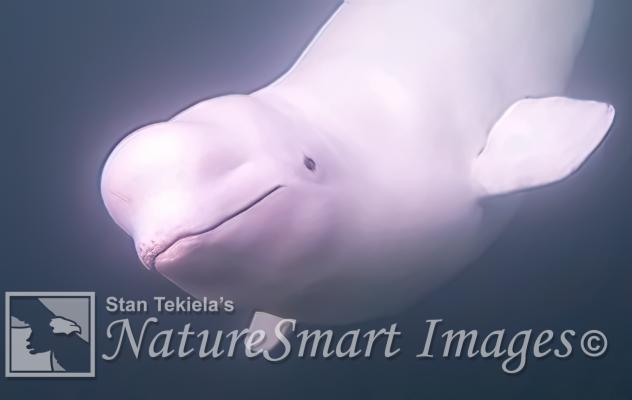View all of the titles in the
NatureSmart Bookstore


by Stan Tekiela
© NatureSmart
December 26, 2023
In the past when I traveled to the arctic to film Polar Bears, I always went during the winter, or perhaps a better way to say that is, I went when there was snow on the ground. After all, capturing images of Polar Bears in snow is the quintessential shot. But when I went this last time, I went specifically during autumn so I could capture images of Polar Bears in the autumn splendor. However, there was a second reason I went at this time of year, the Beluga Whales (Delphinapterus leucas) would still be around.
Getting out on a small boat (zodiac) takes some planning but more importantly, it takes good weather conditions. So, I was keen to watch the weather during my time visiting the Polar Bears along Hudson Bay in northern Manitoba. There was just one morning when the wind wouldn’t be too much, and the skies were almost clear. If we had any chance of seeing the Beluga Whales, it would be this morning.
After a quick safety talk and putting on oversized PFD’s (personal floatation device) we climbed into the zodiac and headed out into open water to see if we could find some Beluga Whales. These whales are sub-Arctic and Arctic species of whale which are very different looking from other whale species. They have a large bulbous head which has led to another common name, Melon-headed Whale.
These aren’t very large whales with the males ranging between 11 and 18 feet in length and weighing between two and three thousand pounds. The females are about 25 percent smaller than the males. As adults they are completely white or whitish-gray in color. The young are born dark gray or blueish gray. It isn’t until they are seven to nine years old do they obtain their full white color as an adult. It is believed that the white skin is an adaptation to life in the Arctic and helps them to blend into the snow and ice surroundings.
The bulbous region on the head contains a compartment that houses the organ that they use for echolocation. Amazingly they can change the shape of the “melon” on their heads by blowing air around its sinuses to help focus the echolocation sounds they emit. In addition to the echolocation, the Beluga Whales are very vocal whales. We could clearly hear the pod of whales “talking” even though we were in a small boat on the water’s surface. We could also hear the intense clicking of the echolocation.
To capture images of the Beluga Whales I mounted my action camera to the end of a selfie stick. I would lean over the edge of the zodiac and plunge the camera down into the cold water. Since signals like “blue tooth” don’t travel through water very well, I didn’t have a way to monitor what I was capturing with the camera. I would place the camera in approximately the spot I thought would work and hoped for the best.
At one point a pod of Beluga Whales swam right up to our boat and approached within inches of my camera. I was so excited that I might be capturing some amazing footage. I was frozen in place, hanging over the side of the boat, just hoping everything with the camera was working when suddenly the whale turned slightly to its side which brought its eye upwards, and I locked eyes with this absolutely amazing creature just a couple feet away. I nearly burst into tears with this personal one-on-one contact.
I was stunned into silents for a moment. It was such a powerful connection and wonderful experience that I had to take a moment to just enjoy the experience and stop thinking about capturing images and video. I just watched the whales which were now all around our boat.
Later when reviewing the video, I could see that the whales would approach the underwater camera with such inquisitive nature. They would look it over and you could almost see them trying to figure out what the camera was and what to do with it. Some even put the action camera in their mouth but without damaging it.
But the best part was, when playing back the video I turned up the volume and I could clearly hear the whales communicating with each other with loud squeaks and pops. In addition, I could hear the constant clicks of the echolocation. Watching the video brings me back to the edge of the zodiac and the amazing experience I had with these fabulous whales. Until next time…
Stan Tekiela is an author / naturalist and wildlife photographer who travels the world to study and capture images of wildlife. He can be followed on www.instagram.com and www.facebook.com. He can be contacted via his website at www.naturesmart.com.
The nationally syndicated NatureSmart Column appears in over 25 cities spanning 7 states: Minnesota, Wisconsin, Michigan, Illinois, Ohio, New York and Pennsylvania. It is a bi-weekly column circulated to over 750,000 readers.
Horned Lark
The overall population of ground nesting birds is steadily going down. Here in North America, we have hundreds of bird species who nest directly on the ground. Prairie birds such as Eastern and Western Meadowlarks are a good example. If you are older than 50 you most likely remember hearing...
Sharp-tailed Grouse
The rights of spring come in many different forms, shapes, colors, and patterns. But the end goal is always exactly the same—reproduction. In nature, everything can be boiled down to one of two things, finding food to survive and mating for reproduction. It’s as simple as...
Greater Prairie Chicken
I am not a stranger to getting up at O’ dark thirty, to be able to get out and capture some images of wildlife. Over the past 40 years I would say it is definitely in the hundreds if not thousands of times I’ve dragged myself out of bed so early. So, last week when the alarm went off...
Marsh Rabbit
For me, I enjoy all aspects of nature, not just birds. I find all of nature fascinating and that is what keeps me interested. So, while leading a photo tour to Florida recently I was so excited to see a crazy cool critter that isn’t what you expect when you see it. A true rule...
Each year, during June and July, Stan Tekiela offers two world-class wildlife photography tours. Here's your chance to learn some tricks of the trade from a top professional.
View all of the titles in the
NatureSmart Bookstore
Check out Stan's latest photos at
NatureSmart Wildlife Images
Do you have any interesting wildlife in your backyard? Any nesting birds, deer, turkeys, reptiles, amphibians, or other unique wildlife? Or maybe a fox or coyote den?
If so, contact Stan at stan@naturesmart.com with your backyard wildlife. If he can get a good photo of the subject, he will send you a print of the photo to hang on your wall.
Order Prints and posters of Stan's photos at
» Prints & Posters
Hear Stan on radio stations all across the Midwest.
» More Info

When he's out in the field, Stan relies on his Vortex Razor binoculars and Vortex Razor spotting scope to help find the subjects for his award winning wildlife photography.

For thirty years, professional wildlife photographer Stan Tekiela has counted on Hunt's Photo and Video to provide him with professional photography equipment.
From tripods to camera bodies and lenses, Hunt's has been Stan's place for everything that he needs. Personal service and prompt shipping means Stan can count on Hunt's to support his professional wildlife photography career.


Professional Wildlife Photographer Stan Tekiela always uses Feeder Fresh in his seed feeders to help keep the feeders and food dry, clean and mold free.
He also uses Feeder Fresh Nectar Defender in all of his hummingbird feeders. It safely keeps nectar fresh longer.